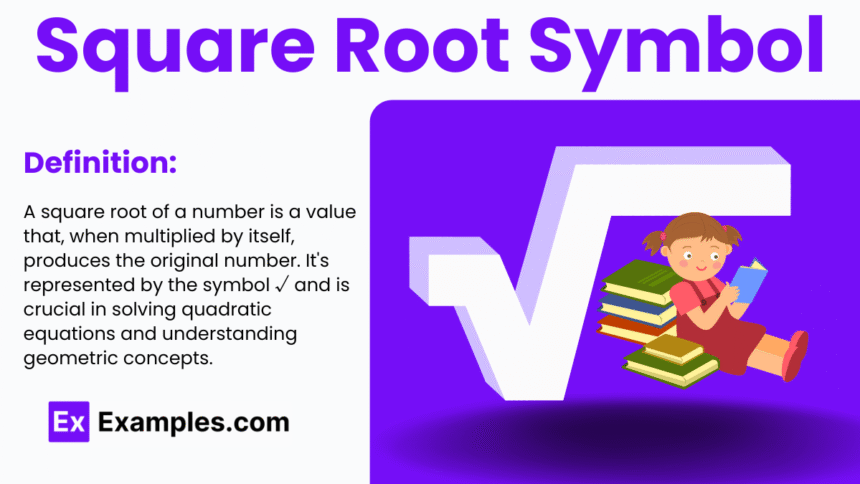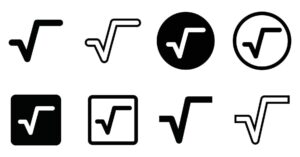The Square Root Symbol: More Than Just a Math Mark
If you’ve ever opened a math book or solved a problem involving square numbers, you’ve likely seen the square root symbol (√). At first glance, it might just look like another part of the mathematical language. But behind this simple sign lies a story of discovery, change, and human curiosity that dates back thousands of years. The square root symbol has traveled through ancient cultures, medieval thinkers, and into our modern classrooms. Let’s take a journey through its fascinating past and present.
What Does the Square Root Symbol Mean?
Before diving into its history, let’s understand what the square root symbol means. In simple terms, the square root of a number is a value that, when multiplied by itself, gives the original number.
For example:
-
√9 = 3 (because 3 × 3 = 9)
-
√25 = 5 (because 5 × 5 = 25)
The symbol √ is placed before a number to show that we’re looking for its square root. It might seem basic now, but this idea took centuries to develop and be clearly written in the way we see today.
Ancient Roots: Where It All Began
Long before the square root symbol existed, people still understood the concept of square roots. Ancient Babylonians, as early as 1800 BCE, used clay tablets to solve problems involving square roots. They didn’t use symbols — they used word descriptions and step-by-step instructions.
The Egyptians also understood this concept, particularly when building pyramids, which required careful measurements and geometry.
Later, Greek mathematicians like Pythagoras and Euclid worked with square numbers and roots. But again, they didn’t use symbols like we do. Instead, they used written language or geometric shapes to explain the ideas.
From Words to Symbols: The Middle Ages
As math spread across cultures, the need for quicker communication grew. Islamic scholars during the Islamic Golden Age (around the 8th to 14th century) translated Greek texts and added their own insights. They used Arabic words like jadhr (meaning “root”) to describe square roots.
In Europe, as Latin became the language of learning, words like radix (Latin for “root”) were used. You might still see “radical” used in math today — it comes from this root word.
But using words for every calculation was slow and hard to write. Mathematicians needed a symbol.
Birth of the Square Root Symbol √
The square root symbol as we know it first appeared in print in 1525, thanks to a German mathematician named Christoff Rudolff. In his algebra book Coss, he used a symbol resembling a modern checkmark or “r” with a long tail — this eventually evolved into the √ symbol.
Some believe Rudolff’s symbol was a stylized version of the Latin letter “r” from radix. Over time, printers and writers smoothed the symbol, and the square root symbol took its current shape.
The symbol stuck because it was easy to write, clear to read, and universal — perfect for spreading mathematical ideas.
Heading: Why the Square Root Symbol Matters Today
Though it may seem like a small symbol, √ plays a huge role in our world.
Here are just a few places where square roots and their symbol show up:
-
Architecture and Engineering: Calculating forces, distances, and measurements often involves square roots.
-
Physics: Square roots appear in formulas for speed, energy, and gravity.
-
Finance: The square root is used to calculate risk and returns.
-
Everyday Math: From measuring rooms to calculating averages, square roots help people make informed decisions.
Even in technology, square root calculations help computers process graphics, animations, and artificial intelligence tasks.
Without the square root symbol, sharing and solving these problems would be slower and harder.
The Square Root in Education: A Student’s Story
Let’s step into a classroom for a moment. Meet Maya, a 13-year-old who just got introduced to square roots.
At first, she found the √ symbol confusing. “It’s like a hook,” she said, “but I don’t know what it’s fishing for.”
Her teacher explained that it’s not fishing — it’s digging. The √ symbol “digs” for the number that, when multiplied by itself, gives the number inside.
Suddenly, things clicked. Maya realized that √64 was just 8, because 8 × 8 = 64. She started enjoying the challenge of solving square root problems, seeing it like a puzzle.
Over time, Maya learned to use the square root symbol in algebra, geometry, and even in some science classes. It became part of her math toolbox — something small, but powerful.
Beyond Numbers: The Square Root in Culture
You might be surprised, but the square root symbol has even shown up in popular culture. It’s been used in tattoos, logos, and even memes. Some people see it as a sign of intelligence or mystery.
In design, its smooth, flowing shape makes it visually interesting. It symbolizes depth, logic, and the beauty of solving problems.
The Digital Age: √ Goes Online
With the rise of computers and smartphones, the square root symbol has made the leap from blackboards to screens.
Math apps, calculators, and software like Excel and Python include the square root function. Typing it might be tricky sometimes, but programmers often use shortcuts like “sqrt” to represent it in code.
Still, the visual symbol √ remains strong. Whether it’s on a calculator app or in an online math game, the symbol reminds us of math’s long history and bright future.
conclusion
It’s easy to take the square root symbol for granted. It’s just a tiny checkmark with a twist, right?
But now you know — it’s much more than that.
It’s a bridge between ancient ideas and modern minds. It’s a key that unlocks puzzles in math, science, and beyond. And it’s a symbol that reminds us how powerful clear thinking and simple symbols can be.
So next time you see √ in a math problem, remember its journey. It’s not just solving for a number — it’s continuing a story that began thousands of years ago.







